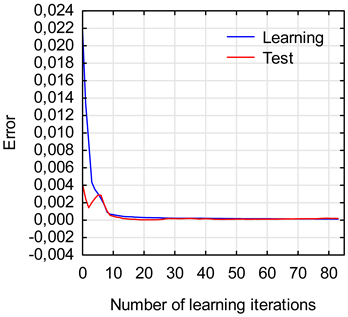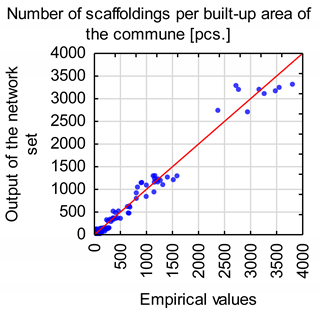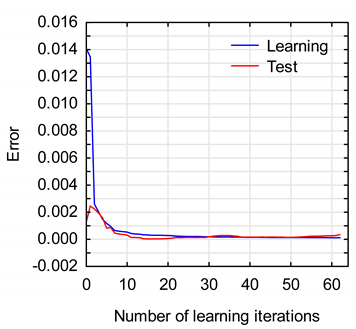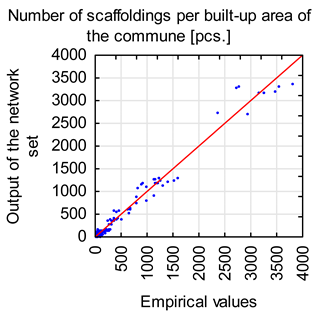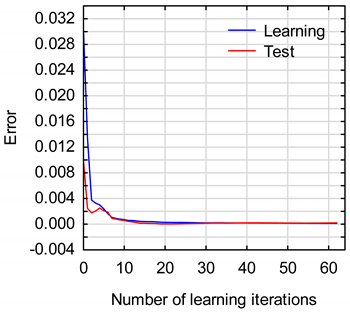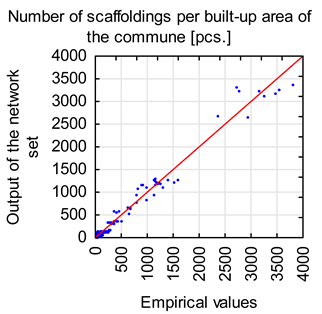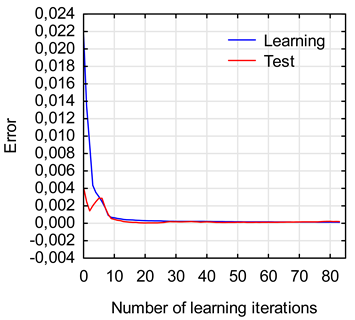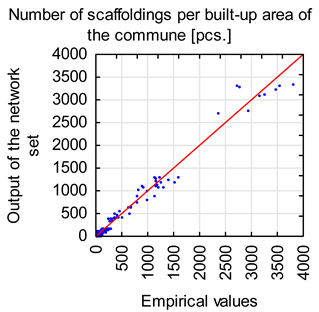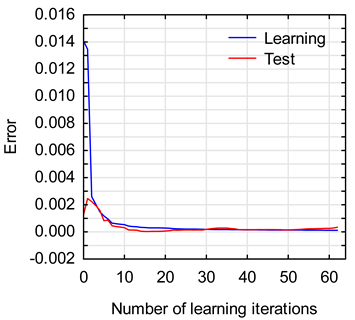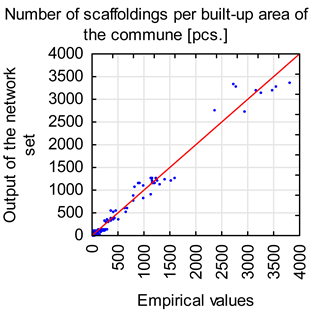Featured Application
The model proposed in the article can be used in both the field of scientific research and in engineering practice, e.g., in the field of economic analyses related to the use of scaffoldings and in the process of managing the occupational safety of work on building scaffoldings.
Abstract
Building scaffoldings are temporary structures that are commonly used in the construction industry. A precise determination of the number of building scaffoldings in use is a very complex task. The literature survey showed that there is a lack of scientific studies concerning the estimation of the scaffolding population in the construction industry. This observation gave rise to the need to undertake such research, the aim of which was to develop a model of a neural network set which would in turn enable the number of used building scaffoldings to be estimated. In order to carry out such a research task, an original research methodology was developed, which used the results of empirical research that involved the counting of construction scaffoldings used in selected representative areas of the studied regions of Poland (the research was carried out in the period from 2016 to 2018), and also data taken from a publication of the Central Statistical Office on socio-economic indicators that characterize the analyzed regions (data from 2010 to 2018). The main element of the developed methodology is a set of five MLP neural networks, which was used to predict the number of used construction scaffoldings. The analysis of the sensitivity of the quantitative and qualitative variables of the model showed that they have a significant impact on the final result generated by the networks. The obtained results of the research and analyses showed the size of the population of building scaffoldings used in individual regions of Poland, and also the seasonality of their occurrence. The knowledge obtained on this basis can be used, among others, in economic analyses related to the use of construction scaffolding, as well as in the process of managing occupational safety on scaffoldings. The most important scientific aspect of the article concerns the development of an original methodology for estimating the population of building scaffoldings.
1. Introduction
Building scaffoldings are temporary structures commonly used in the construction industry. According to [1], they can be used, to provide:
- Safety during work when erecting, maintaining, repairing or demolishing buildings and other structures;
- Easy access to elements and parts of construction objects located in hard-to-reach places—e.g., at heights;
- Support for the elements of a structure being erected during their construction; and
- Adequate vertical communication (e.g., temporary staircases) and horizontal communication (e.g., temporary footbridges).
With such a wide area of use for scaffoldings in the construction industry, the large number of construction solutions available on the market, and the fact that the work carried out with their use are conducted at height and in changing weather conditions mean that these works are burdened with a high occupational risk [2,3] and are considered particularly dangerous [4,5].
A precise determination of the number of building scaffoldings in use is a very time-consuming and costly task, and in the case of a large geographical area of analysis, it is nearly impossible to perform. An in-depth study of the literature showed that there is a lack of scientific studies concerning the estimation of the scaffolding population in the construction industry. This observation gave rise to the need to undertake such research and fill the identified research gap. Neural networks were used to solve the problem.
Neural networks are commonly used for the classification, prediction and analysis of data sets [6,7]. The operation of a neural network is based on the functioning of a natural biological network of nerve cells [8,9,10]. Artificial neural networks are tools that are willingly used in various fields of science, including construction engineering [11]. One example of their practical implementation can be found in paper [12], in which a model of a neural network was proposed. This model enabled the compressive strength of a cement composite containing ground granular blast furnace slag (GGBFS) to be predicted. The developed model allowed for important strength parameters of the tested composite to be accurately estimated. The usefulness of neural networks for predicting the parameters of building materials can also be found in paper [13]. In this case, a neural network model was used to predict the strength of rubberized concrete containing silica dust and zeolite. In turn, in study [14], a model of a neural network was proposed in order to determine the effect of freezing and thawing on the occurrence of damage to fiber-cement boards.
Neural networks can also be used in the area of managing construction projects, e.g., for predicting time and cost claims in construction projects [15], for modeling the work process of construction teams [16,17] and construction equipment [18], and for estimating construction costs [19,20]. One example of such an implementation is a paper [21] in which the proposed neural network model enabled general construction costs to be estimated. In the above studies, a database containing 143 cases of completed construction projects was used to build the model. The developed model enabled the general building cost index to be predicted with a high degree of accuracy. Other research in which artificial neural networks were used include a study [22] in which the authors focused on the analysis of the efficiency of earthmoving machines. The neural network presented allowed for the prediction of efficiency, unit losses, and unit costs on the basis of parameters, such as the number of excavators and trucks, and also the capacity of both the truck and excavator buckets.
In analyses related to occupational safety, neural networks can be used to predict and evaluate the behavior of employees during the execution of a building project [23,24], to predict the level of risk of work carried out at heights [25], and to identify risk factors [26].
The main purpose of the research carried out and presented in the article was to develop a model of a neural network that would allow the number of building scaffoldings used in the analyzed area to be estimated. To solve such a research task, the following were used:
- Results of empirical research, which involved the counting of the number of scaffoldings in the selected representative areas; and
- Statistical data on socio-economic indicators in the analyzed regions.
The most important scientific aspect of the article concerns the development of an original methodology for estimating the population of building scaffoldings. This methodology is based on an MLP neural network set. The number of scaffoldings determined by the neural network can be used, among others, in economic analyses related to the use of construction scaffolding, and also in the process of managing the safety of work on building scaffoldings. The information obtained as a result of the research will be used in the future to predict the probability of an accident on building scaffolding.
During the calculations, commonly known and applied mathematical tools were used. The calculations were conducted using Statistica software (Statistica, Version 13.1, Statsoft, Kraków, Poland, 2021).
2. Materials and Methods
2.1. Neural Networks—Multilayer Perceptron (MLP)
Every artificial neural network consists of a network of interconnected elements (so-called neurons), each of which has a certain number of inputs and one output. Neurons are arranged in layers and are interconnected. In a typical neural network, the following layers can be distinguished:
- Input layer—responsible for the introduction of the values of variables to the network ();
- Hidden layer—responsible for the processing of information; and
- Output layer—responsible for determining the output value of network (result).
In the case of very complex neural networks, their structure may contain more than one hidden layer. However, as shown by current practice [27], it is recommended to build a network with up to two hidden layers. Moreover, in most cases, a single hidden layer combined with an appropriate number of neurons can solve the same problem with a comparable level of accuracy. However, it is important that the activation function of the hidden neurons is a non-linear function.
Connections between individual neurons in adjacent layers are made using so-called synapses, which are responsible for passing information between elements (). It should be noted that the transmitted signal in each case is modified by a numerical factor—the so-called weight , where is the number of the neuron from which the signal is taken (), and is the number of the neuron to which the signal is supplied (). The values of individual weights are determined in the process of learning the network and are responsible for the so-called network’s “memory,” i.e., its ability to predict results based on new variable values. In the case when the value of the weight parameter is positive, the neuron to which the information is delivered is activated, and when the value of the weight parameter is negative, the neuron is inhibited.
Figure 1 shows an exemplary structure of a two-layer neural network with one hidden layer.
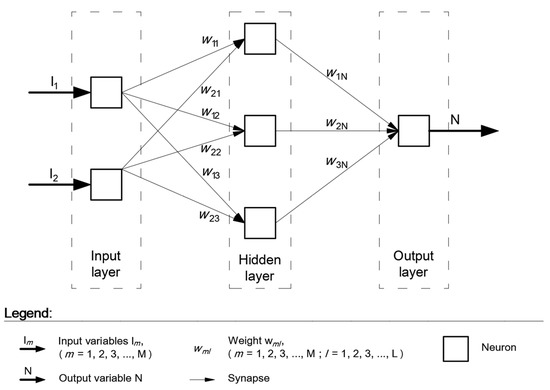
Figure 1.
Exemplary structure of a two-layer neural network.
A typical neuron in the hidden layer and output layer of the network consists of the aggregation function and the activation function (Figure 2).

Figure 2.
Construction of a typical neuron found in the hidden layer or output layer.
The aggregation function is responsible for the aggregation of the input data, i.e., the connection of the information transmitted by the synapse from the neuron of the previous layer with the appropriate weight parameter that is assigned to this connection. In practice [27], the aggregation function is most often a linear function: , or a radial function: . However, in the case of tasks other than classification, it is recommended to use the linear aggregation function [27].
The aggregated input value of a given neuron becomes its activation function parameter ). The activation function can be linear, sigmoidal, tangensoidal, Gaussian, or another function. In practice, according to [27], it is recommended to use linear or sigmoidal activation functions on for solving tasks related to the prediction and modeling of a phenomenon.
When developing a neural network model, it is very important to properly select the input variables, the number of neurons, the number of hidden layers, and the aggregation and activation functions in individual neurons. However, there are techniques that allow for the automatization of this procedure, such as grid search, random search, Bayesian optimization, and evolutionary optimization.
The network components should be selected in a well-thought-out manner by those developing a model. There are techniques to automate this procedure, such as: grid search, random search, Bayesian optimization, and evolutionary optimization.
The data set used during the development of a neural network model, i.e., the set of empirical values and the values of the variables that characterize the analyzed phenomena, should be divided into three sets [28]:
- Training set—usually contains 70% of all the observations that are used to properly develop a neural network model, i.e., “active” learning of the network [27];
- Test set—usually contains 15% of all the observations that are used to verify the developed network model;
- Validation set—most often contains 15% of all the observations and is used to detect the risk of network overlearning, i.e., excessive adaptation of the network to the training set.
A correctly developed model with the use of neural networks should be characterized by a high quality of matching to the analyzed phenomenon, i.e., it should have the highest possible (preferably close to one) value of the correlation coefficient between the empirical values and the values obtained by the model. In practice, this comes down to comparing the quality of adjustment of the developed model to the training, testing, and validation sets, the values of which should be comparable with each other.
2.2. The Scope of Research
The subject of this study was the development of a mathematical model based on an artificial neural network, which enables the number of construction scaffoldings used in the analyzed regions of Poland to be estimated. The analysis was limited to five regions of the country: Dolnoslaskie, Lubelskie, Lodzkie, Mazowieckie and Wielkopolskie. Each of the analyzed regions is administratively divided into communes, the total number of which in all the analyzed regions is equal to 1099. In addition, the research was only limited to the analysis of operating scaffoldings, which according to a definition [29] constitute: “a temporary building structure, on which works at height involving the maintenance of people, materials and equipment can be conducted.”
The analysis was performed on the basis of collected empirical data for the period from 2016 to 2018, and also the statistical data of the Central Statistical Office [30]. The calculations were conducted using Statistica software (Statistica, Version 13.1, Statsoft, Kraków, Poland, 2021).
2.3. Research Methodology
In order to estimate the number of scaffoldings in the studied regions of Poland, an original research methodology was developed, which consists of the following stages:
- Empirical determination of the number of building scaffoldings in use in representative areas of regions ;
- Identification of socio-economic indicators ;
- Classification of the analyzed communes with regards to their socio-economic development; and
- Development of a neural network model.
The individual stages of the developed methodology are presented in Figure 3.
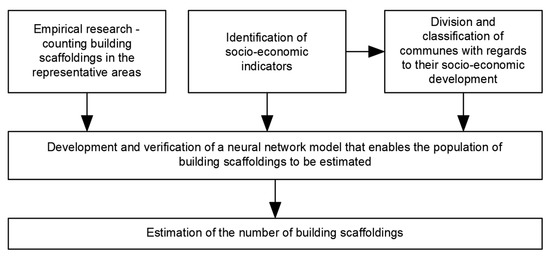
Figure 3.
Original methodology for estimating the number of building scaffoldings.
2.3.1. Empirical Determination of the Number of Scaffoldings in Use
For the purpose of the research, data collected as a result of the empirical counting of scaffoldings in the selected areas of 30 analyzed localities (which differ regarding the nature of their building developments and degree of industrialization) were used. As a result, the data adopted for the analysis constitute a representative sample of all the communes included in the analyzed five regions of the country (V). An in situ scaffolding count was conducted cyclically every two months from the second quarter of 2016 to the third quarter of 2018 as part of the ORKWiZ research project (“Model of the assessment of risk of the occurrence of building catastrophes, accidents and dangerous events at workplaces with the use of scaffolding”).
The counting covered all the construction scaffolding located in generally accessible places in the selected counting areas. The number of scaffoldings obtained in the representative areas was scaled to the area of the entire commune, while at the same time taking into account its character of housing developments.
For example, Figure 4 shows the results of empirical research for six communes in the Dolnoslaskie region.

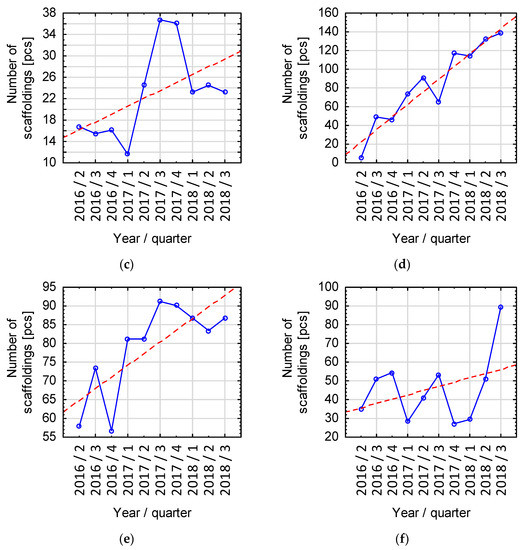
Figure 4.
The designated number of scaffoldings in the analysed towns of the Dolnoslaskie region in the period from 2016 to 2018: Wroclaw—the capital of the region (a); Jawor (b); Jelcz-Laskowice (c); Siechnice (d); Sroda Slaska (e); Swidnica (f).
On the basis of the above graphs, it can be noticed that there was a much greater number of scaffoldings used in the capital of the region (Wroclaw) when compared to other communes of Dolnoslaskie. Additionally, in the case of the communes of Wroclaw and Swidnica, the phenomenon of seasonality in the use of construction scaffoldings was the most visible.
2.3.2. Identification of Socio-Economic Indicators
As was mentioned at the beginning of the paper, scaffolding is a structure that is commonly used in all areas of the construction industry when working at height. Therefore, the number of scaffoldings used in a given area is directly related to the number of investments carried out, the economic development of a given region, the number of the region’s inhabitants, and the number of construction industry companies. On the basis of previous studies [31,32,33] and the conducted analysis of publicly available statistical data, several economic indicators , which characterize the regions in terms of socio-economic development, were selected. These indicators are summarized in Table 1.

Table 1.
Socio-economic indicators .
The numerical values of individual indicators were obtained from the Statistical Yearbooks of Voivodeships [34] and the Local Data Bank [30]. The obtained data presents numerical values for the individual quarters of the year.
Pearson’s correlation coefficient was used to test the strength of the correlation between the number of used scaffoldings obtained as a result of empirical research and the values of individual indicators. The determined values of Pearson’s correlation coefficients are presented in Table 2.

Table 2.
Values of the Pearson’s correlation coefficients .
By analyzing the obtained values of Pearson’s correlation coefficients , it can be concluded that all the socio-economic indicators adopted for the analysis show a very high (), or almost full (), degree of correlation. The obtained high values of Pearson’s correlation coefficients also prove that it is possible to develop a neural network model that will allow the number of used scaffoldings to be predicted on the basis of the socio-economic indicators .
2.3.3. Classification of Communes with Regards to Socio-Economic Development
The conducted preliminary analysis of the obtained statistical data showed significant differences between the regions, especially in terms of types of buildings and degrees of industrialization. This fact was also observed in previous studies [31,33].
Before the development of the neural model, all the communes included in the studied regions were classified into groups , which are characterized by similar socio-economic indicators. This classification was taken into account when developing the final neural model. The group number is one of the qualitative input variables of the model and significantly affects its final accuracy.
For the classification of the communes, a statistical method—cluster analysis—was used [35]. In the first step of the classification, calculations using the hierarchical method and the agglomeration grouping technique [36] were proposed and performed. The following were assumed during the calculations:
- The Euclidean distance between the analyzed objects [36];
- A binding method according to the method of Ward [37]; and
- Grabiński’s method for the determination of the expected number of clusters [38].
By having information concerning the expected number of clusters , it was possible to perform the final analysis of grouping the communes using the non-hierarchical k-means grouping method.
As a result of the conducted classification of all the 1099 communes into groups with similar economic potential, four subsets of were obtained. Each of the obtained subsets included communes with similar values of socio-economic indicators.
Group includes four communes, which constitute only large cities, i.e., Wroclaw, Lodz, Warsaw and Poznan. These are communes characterized by a very large number of inhabitants and very high economic development, which makes this group clearly different from the other groups. The vast majority of rural and urban–rural communes were included in groups and (791 communes—group , and 129 communes—group . In the communes from group there was a smaller number of new housing investments and a smaller urbanized area when compared to the communes from group . 175 urban communes which have a high degree of urbanized area in relation to the total area of the commune were classified as group .
2.3.4. Neural Models for Predicting the Number of Used Scaffoldings
The preliminary calculations showed that for the analyzed data set the best results could be obtained from a network in which the number of neurons in the hidden layer ranged between 5 and 20. Therefore, in the course of the calculations, 80 different neural networks which had the number of hidden layer neurons ranging from 5 to 20, were manually developed. In accordance with recommendations [27], the following were adopted for the construction of the model:
- A linear aggregation function in all the neurons of the hidden layer;
- A linear aggregation function in all the neurons of the output layers;
- A sigmoid activation function in all the neurons of the hidden layer; and
- A linear activation function in all the neurons of the output layer.
During each iteration step, the value of individual weights was optimized on the basis of the error function that the network makes according to the BFGS algorithm (Broyden–Fletcher–Goldfarb–Shanno), also known as the variable metric method. All the calculations were carried out using Statistica software.
The data set used in the calculations, which consists of 295 independent observations (formulas used to develop the models), was divided into the following sets: training, testing, and validation, in the ratio of 70%, 15%, and 15%, respectively.
All the networks were built on the basis of quantitative variables (economic indicators ) and qualitative variables such as: region , quarter of the year and the number of the group . The qualitative variables were encoded using the one-of-N method, which allows for the conversion of the nominal values to a numerical form [7]. Coding with the use of this method involves the assignment of a vector of binary values with a length equal to the number of all permissible values of a given variable to each qualitative variable. The general structure of the developed single MLP network is shown in Figure 5.
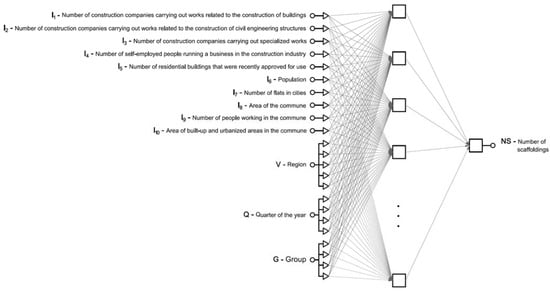
Figure 5.
Construction of a single MLP network.
3. Results
3.1. Neural Model for Predicting the Number of Used Scaffoldings
From all the 80 developed models, five neural networks (characterized by the best quality of adjustment to the adopted data set) were selected for further analysis. The adoption of five neural networks for further calculations was justified by the fact that these networks were characterized by a similarly high level of quality, as expressed by the correlation coefficient and the low value of the root-mean-square error (RMSE). In addition, the quality of the selected networks was better than the other networks that were also developed. The full characteristics of the neural networks selected for the further analysis are presented in Table 3 and Table 4.

Table 3.
Characteristics of the developed neural networks.

Table 4.
Characteristics of the developed neural networks—graphs.
The results presented in Table 4 allow for a graphic interpretation of the obtained results. In particular, the analysis of the network learning graph allows for the statement that the learning process mainly took place in the period up to about the 10th cycle in the case of networks 1, 3, 4, and 5, and up to about the 15th cycle in the case of network 2.
Afterwards, in order to increase the accuracy of the final estimate of the number of used scaffoldings, the so-called network set, which consists of five previously developed and selected models, was used. According to [27,39], the use of such a set contributes to the reduction of the prediction error. Figure 6 presents a comparison of empirical values and the results obtained with the help of the developed set of networks. The vast majority of the obtained results fall within the confidence level of 0.95 of the model’s prediction.
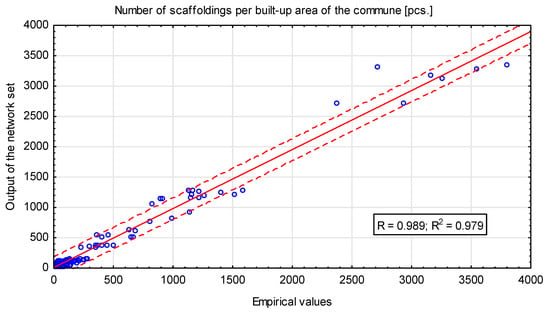
Figure 6.
Graph of the quality of matching the output values of the set of networks and the empirical values (in red: the area of the confidence level of 0.95 of the model’s prediction).
3.2. Estimating the Number of Used Scaffoldings
The developed model of the neural network set was used to predict the number of scaffoldings in use in all the communes of the analyzed regions. By summing up the values obtained for individual communes included in the region, the number of building scaffoldings in use in the analyzed regions of Poland was obtained. Figure 7 shows an example of the estimation of the number of scaffoldings for the Dolnoslaskie region in the period from 2011 to 2018 (divided into year quarters and group numbers ).
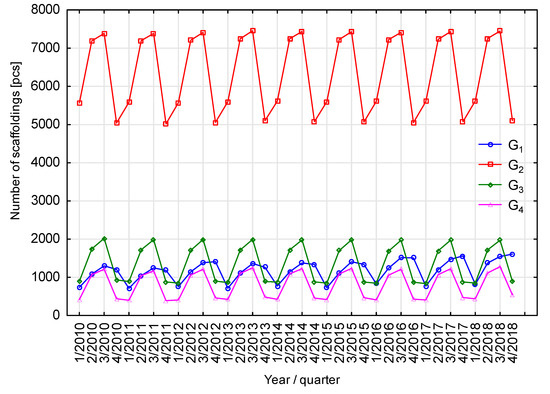
Figure 7.
Number of scaffoldings in the Dolnoslaskie region (divided into groups ) estimated using the neural network set.
The obtained results, which were generated using the developed model of the neural network set, indicate a clear seasonality in the use of scaffoldings. Moreover, it was observed that the greatest number of scaffoldings used in communes was be found in group which in the case of the Dolnoslaskie region had 98 communes. In groups , and , which had 1, 35, and 35 communes, respectively, a clearly lower total number of used scaffoldings per year was observed.
4. Discussion of the Results
The conducted in situ research allowed for the collection of information concerning the number of used scaffoldings in selected regions of Poland. The obtained research results show a clear seasonality in the use of scaffoldings. It can be observed that in the second and third quarter of the year, there is an increase in the number of scaffoldings in use by an average of approximately 50% when compared to the first and fourth quarters. The largest difference is noticeable in the communes included in groups and (111% and 164%, respectively). These groups had a total of 70 communes and were characterized by a high number of new residential buildings (, and a relatively large area of built-up and urbanized land (). In the communes from group , the fluctuation in the amount of scaffolding in use was 37% per year. The smallest fluctuations were observed in group (approximately 20%), which in the Dolnoslaskie region included only one commune—Wroclaw—the capital, and the largest city of the region.
By analyzing the neural models obtained as a result of the calculations, it can be concluded that all five individual neural network models were characterized by a high quality of adjustment to the analyzed phenomenon (quality of network learning close to one), without showing an excessive adjustment of the network to the training set (quality of network validation close to one). Additionally, the analysis of the learning process graphs (Table 4) clearly shows that the network learning process was correct [27]. A similar and very high quality of matching the results to the empirical values is observed in the case of the developed neural network set (; ).
The detailed analysis of the developed neural networks allows for the conclusion that all the networks were developed correctly. The sensitivity analysis of all the quantitative and qualitative variables that were used to build the models showed that in each case, all the variables had a significant impact on the final result of the network (the values of the sensitivity coefficient in all the cases were greater than 1.0 [27]), as seen in Figure 8.
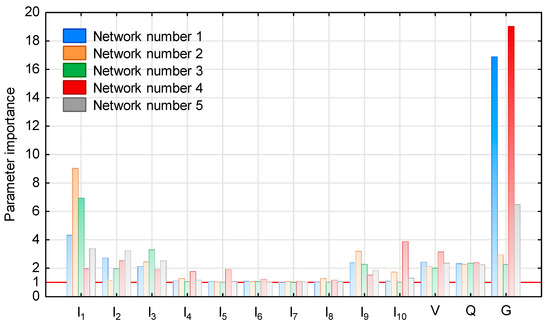
Figure 8.
Sensitivity analysis of all the variables that were used to build the network.
When analyzing the above chart, it can be noticed that the input (group numbers) and the input (number of construction companies carrying out work related to the construction of buildings) had the greatest impact on the final result of the network. This situation is due to the fact that the number of building scaffoldings in use depends to a large extent on the number of construction companies carrying out construction work and on the nature of a given commune—in particular, the degree of its industrialization. Additionally, depending on the type of network, the impact of individual parameters was different. An example can be seen in network number 1, in which the parameter had a greater influence on the final result than the parameter. In the case of network number 2, the situation was the opposite—the parameter had a smaller impact on the network result than the parameter.
In order to verify the developed neural network models, alternative mathematical models were built, with the results generated by both types of models then being compared. Linear regression was used to build the verifying models. As a result of the performed calculations, four different linear models were developed—one for each group of communes. The developed linear models are characterized by a very high degree of matching to reality. This is evidenced by the obtained statistics of , and , which were close to one.
The developed linear models were used to estimate the number of building scaffoldings in all the analyzed communes, and the obtained results were then compared with the results obtained from the model of the neural network. The high value of Pearson’s correlation coefficient (R = 0.89), which was obtained in this way, proves the very high correlation between the results generated by both types of models. A certain advantage of the network set model over the linear models is the fact that it showed a higher degree of adjustment to empirical values— and (MLP model); and (linear models).
5. Conclusions
The aim of the research undertaken and described in this article was to develop a neural network model that would allow for the estimation of the number of used scaffoldings. In order to implement such a research task, an original research methodology was developed, which consisted of the following stages:
- Empirical determination of the number of used scaffoldings in the selected representative areas of the studied regions;
- Identification and analysis of data concerning the socio-economic indicators that characterize the analyzed regions;
- Classification of the analyzed communes with regards to socio-economic development; and
- Development of a neural model.
The main element of the developed methodology was a model consisting of five neural networks, which was used to predict the number of used scaffoldings in the studied regions. The sensitivity analysis of all the quantitative and qualitative variables showed that all the variables used to build the neural models had a significant impact on the final result of the network.
The obtained results of the research and analyses show the size of the population of scaffoldings used in individual regions of Poland, as well as the seasonality of their occurrences.
In addition, the results obtained in the course of the conducted analyses provide a noticeable benefit for researchers and other research recipients. This is due to the fact that they can be a starting point for further analyses, e.g., those related to the estimation of the population of building scaffoldings in other countries.
The model proposed in the article can be used in both the field of scientific research and in engineering practice, e.g., in the field of economic analyses related to the use of scaffoldings. In addition, the information obtained using the model may be the basis for insurance analyses of construction work carried out with the use of scaffolding. Moreover, it can also be used in the process of managing occupational safety of work on building scaffoldings. In addition, the data concerning the population of building scaffoldings which was obtained as a result of the conducted research, combined with data on occupational accidents, may constitute a basis for determining the probability of an accident on scaffolding.
Funding
This research was funded by NCBiR within the framework of the Programme for Applied Research, grant number PBS3/A2/19/2015.
Institutional Review Board Statement
Not applicable.
Informed Consent Statement
Not applicable.
Data Availability Statement
No new data were created or analyzed in this study. Data sharing is not applicable to this article.
Acknowledgments
The article is the result of the implementation by the authors of research project No. 244388 “Model of the assessment of risk of the occurrence of building catastrophes, accidents and dangerous events atworkplaces with the use of scaffolding,” financed by NCBiR within the framework of the Programme for Applied Research on the basis of contract No. PBS3/A2/19/2015.
Conflicts of Interest
The author declares no conflict of interest.
References
- Kmiecik, P.; Gnot, D.; Jurkiewicz, R.; Nowicka-Słowik, E.; Brajza, M. Working and Protective Scaffolding; The Publishing House of PWN: Warsaw, Poland, 2018; ISBN 978-83-01-19771-1. [Google Scholar]
- Hoła, A.; Sawicki, M.; Szóstak, M. Methodology of Classifying the Causes of Occupational Accidents Involving Construction Scaffolding Using Pareto-Lorenz Analysis. Appl. Sci. 2018, 8, 48. [Google Scholar] [CrossRef] [Green Version]
- Szóstak, M.; Hoła, B.; Bogusławski, P. Identification of accident scenarios involving scaffolding. Autom. Constr. 2021, 126, 103690. [Google Scholar] [CrossRef]
- Regulation of the Minister of Labour and Social Policy from September 26, 1997 on general provisions concerning occupational health and safety. J. Laws 2003, 169, 1650.
- Regulation of the Minister of Infrastructure from June 23, 2003 concerning information on safety and health protection and the safety and health protection plan. J. Laws 2003, 120, 1126.
- StatSoft Electronic Statistics Manual PL. Available online: https://www.statsoft.pl/textbook/stathome.html (accessed on 1 July 2021).
- Tadeusiewicz, R. Neural Networks; Akademicka Oficyna Wydawnicza: Warsaw, Poland, 1993; ISBN 83-85769-03-X. [Google Scholar]
- Neira, P.; Bennun, L.; Pradena, M.; Gomez, J. Prediction of concrete compressive strength through artificial neural network. Gradjevinar 2020, 72, 585–592. [Google Scholar]
- Madani, H.; Kooshafar, M.; Emadi, M. Compressive Strength Prediction of Nanosilica-Incorporated Cement Mixtures Using Adaptive Neuro-Fuzzy Inference System and Artificial Neural Network Models. Pract. Period. Struct. Des. Constr. 2020, 25. [Google Scholar] [CrossRef]
- Silva, F.A.N.; Delgado, J.M.P.Q.; Cavalcanti, R.S.; Azevedo, A.C.; Guimarães, A.S.; Lima, A.G.B. Use of nondestructive testing of ultrasound and artificial neural networks to estimate compressive strength of concrete. Buildings 2021, 11, 44. [Google Scholar] [CrossRef]
- Flood, I. Neural Networks in Civil Engineering: A Review. In Civil and Structural Engineering Computing: 2001; Topping, B.H.V., Ed.; Saxe-Coburg Publications: Stirlingshire, UK, 2001; Chapter 8; pp. 185–209. [Google Scholar] [CrossRef]
- Czarnecki, S.; Shariq, M.; Nikoo, M.; Sadowski, Ł. An intelligent model for the prediction of the compressive strength of cementitious composites with ground granulated blast furnace slag based on ultrasonic pulse velocity measurements. Meas. J. Int. Meas. Confed. 2021, 172. [Google Scholar]
- Jalal, M.; Arabali, P.; Grasley, Z.; Bullard, J.W. Application of adaptive neuro-fuzzy inference system for strength prediction of rubberized concrete containing silica fume and zeolite. Proc. Inst. Mech. Eng. Part L J. Mater. Des. Appl. 2020, 234, 438–451. [Google Scholar] [CrossRef]
- Gorzelańczyk, T.; Schabowicz, K. Effect of freeze-thaw cycling on the failure of fibre-cement boards, assessed using acoustic emission method and artificial neural network. Materials 2019, 12, 2181. [Google Scholar] [CrossRef] [Green Version]
- Yousefi, V.; Yakhchali, S.H.; Khanzadi, M.; Mehrabanfar, E.; Šaparauskas, J. Proposing a neural network model to predict time and cost claims in construction projects. J. Civ. Eng. Manag. 2016, 22, 967–978. [Google Scholar] [CrossRef]
- Gerek, I.H.; Erdis, E.; Mistikoglu, G.; Usmen, M. Modelling masonry crew productivity using two artificial neural network techniques. J. Civ. Eng. Manag. 2015, 21, 231–238. [Google Scholar] [CrossRef] [Green Version]
- Juszczyk, M. Analysis of labour efficiency supported by the ensembles of neural networks on the example of steel reinforcement works. Arch. Civ. Eng. 2020, 66, 97–111. [Google Scholar]
- Golnaraghi, S.; Zangenehmadar, Z.; Moselhi, O.; Alkass, S.; Vosoughi, A.R. Application of Artificial Neural Network(s) in Predicting Formwork Labour Productivity. Adv. Civ. Eng. 2019, 2019, 1–11. [Google Scholar] [CrossRef] [Green Version]
- Leśniak, A.; Juszczyk, M.; Piskorz, G. Delays factors of a completion construction project aggregation with the use of cluster analysis. Mater. Bud. 2018, 10, 62–65. [Google Scholar]
- Wilmot, C.G.; Mei, B. Neural Network Modeling of Highway Construction Costs. J. Constr. Eng. Manag. 2005, 131. [Google Scholar] [CrossRef]
- Leśniak, A.; Juszczyk, M. Prediction of site overhead costs with the use of artificial neural network based model. Arch. Civ. Mech. Eng. 2018, 18, 973–982. [Google Scholar] [CrossRef]
- Schabowicz, K.; Hoła, B. Application of artificial neural networks in predicting earthmoving machinery effectiveness ratios. Arch. Civ. Mech. Eng. 2008, 8, 73–84. [Google Scholar] [CrossRef]
- Patel, D.A.; Jha, K.N. Evaluation of construction projects based on the safe work behavior of co-employees through a neural network model. Saf. Sci. 2016, 89, 240–248. [Google Scholar] [CrossRef]
- Patel, D.A.; Jha, K.N. Neural Network Model for the Prediction of Safe Work Behavior in Construction Projects. J. Constr. Eng. Manag. 2015, 141, 04014066. [Google Scholar] [CrossRef]
- Nguyen, L.D.; Tran, D.Q.; Chandrawinata, M.P. Predicting Safety Risk of Working at Heights Using Bayesian Networks. J. Constr. Eng. Manag. 2016, 142, 04016041. [Google Scholar] [CrossRef]
- Xu, N.; Ma, L.; Liu, Q.; Wang, L.; Deng, Y. An improved text mining approach to extract safety risk factors from construction accident reports. Saf. Sci. 2021, 138, 1–21. [Google Scholar] [CrossRef]
- Tadeusiewicz, R.; Migut, G. Neural Networks-Training Materials; StatSoft Polska: Krakow, Poland, 2019. [Google Scholar]
- Shahin, M.A.; Maier, H.R.; Jaksa, M.B. Data Division for Developing Neural Networks Applied to Geotechnical Engineering. J. Comput. Civ. Eng. 2004, 18. [Google Scholar] [CrossRef]
- Regulation of the Minister of Infrastructure from February 6, 2003 concerning occupational health and safety during construction works. J. Laws 2003, 47, 401.
- Central Statistical Office (GUS)-Local Data Bank. Available online: http://www.stat.gov.pl/bdlen/app/strona.html?p_name=indeks (accessed on 1 July 2021).
- Hoła, B.; Nowobilski, T. Classification of Economic Regions with Regards to Selected Factors Characterizing the Construction Industry. Sustainability 2018, 10. [Google Scholar] [CrossRef] [Green Version]
- Hoła, B.; Nowobilski, T. Analysis of the influence of socio-economic factors on occupational safety in the construction industry. Sustainability 2019, 11, 4469. [Google Scholar] [CrossRef] [Green Version]
- Nowobilski, T.; Hola, B. The Qualitative and Quantitative Structure of the Causes of Occupational Accidents on Construction Scaffolding. Arch. Civ. Eng. 2019, LXV, 121–131. [Google Scholar] [CrossRef]
- Central Statistical Office. Statistical Yearbook of Voivodships from 2007–2019; Central Statistical Office: Warsaw, Poland, 2020. [Google Scholar]
- Wierzchoń, S.; Kłopotek, M. Cluster Analysis Algorithms; Wydawnictwo WNT: Warsaw, Poland, 2015; ISBN 978-83-7926-261-8. [Google Scholar]
- Stanisz, A. An Accessible Course in Statistics Using STATISTICA PL and Examples from Medicine, Volume 3: Linear and Nonlinear Models; StatSoft Polska: Krakow, Poland, 2007; ISBN 978-83-88724-19-0. [Google Scholar]
- Ward, J.H.J. Hierarchical Grouping to Optimize an Objective Function. J. Am. Stat. Assoc. 1963, 58, 236–244. [Google Scholar] [CrossRef]
- Grabiński, T. Taxonometric Methods; University of Economics in Krakow: Krakow, Poland, 1992. [Google Scholar]
- Juszczyk, M.; Zima, K.; Lelek, W. Forecasting of sports fields construction costs aided by ensembles of neural networks. J. Civ. Eng. Manag. 2019, 25, 715–729. [Google Scholar] [CrossRef] [Green Version]
Publisher’s Note: MDPI stays neutral with regard to jurisdictional claims in published maps and institutional affiliations. |
© 2021 by the author. Licensee MDPI, Basel, Switzerland. This article is an open access article distributed under the terms and conditions of the Creative Commons Attribution (CC BY) license (https://creativecommons.org/licenses/by/4.0/).
